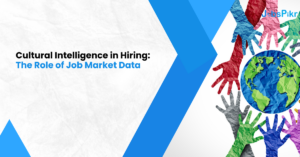Data drives businesses.
In every sector, every department, and every type of establishment imaginable, data has a role to play in shaping and growing that entity.
With such importance, leveraging analytics especially, job data analytics can be tremendously valuable in today’s job market.
By analyzing job data, recruiters and hiring managers can make sense of the dynamic changes in the labor market, uncover hidden trends, and optimize strategies for efficient planning.
Let’s understand how.
Exploring Data Analytics in the Job Market
The job market is a goldmine of data, filled with information about job titles, skills, salary ranges, and more. Traditional means of collecting data like relying on the reviewer’s experiences or intuition to make certain important recruiting decisions fall short of today’s requirements.
It can also result in terrible decisions such as letting a good candidate go due to certain biases or hiring an unfit employee.
However, with the advent of job data analytics, a wealth of untapped information is now available to assist in making better decisions to hire the right people.
Job data analytics pertains to the collection, analysis, and interpretation of market and job-related data to identify patterns and uncover trends in the market.
For example, the interpretation of this data can show how sustainability engineers are rising in prominence due to several organizations and countries prioritizing sustainability and eco-friendly initiatives. This knowledge can be used to ramp up efforts in the same direction to stay on par with other companies in the industry.
This job data is aggregated from several sources such as job boards, company websites, and social media platforms such as LinkedIn.
Access to this data shapes other recruitment and hiring processes, making the organization stay current with growing demands.
The Power of Extracting Insights from Job Data
Extracting insights from job data can provide organizations with a competitive edge in hiring the right talent. By analyzing job postings, recruiting teams can identify –
- High-demand skills
- Job trends
- Industry shifts.
This information can then be utilized to create targeted job descriptions and attract the right candidates.
Job data analytics also enables organizations to understand the pulse of the market. For example, the data in the image below shows how India’s hiring has ebbed and flowed throughout the months of 2023.
This information gives a clear picture of how the market is faring and for organizations looking to hire, the likely competition they are going to face.
The Process of Uncovering Hidden Trends with Job Data Analytics
Uncovering hidden trends within job data requires a systematic approach and the use of advanced analytics tools. While most platforms process and share insights as per requirements, those opting for raw data can follow the below process –
- Data Collection
How do you process data without collecting it? You don’t. The collection of relevant job data from sources important to you is an obvious and essential first step.
This data may include information on job titles, skills, qualifications, salary ranges, and more. Once you’ve identified the fields important to your business, gathering the right information puts you on the right track.
- Data Cleaning
Every website organizes data differently. They have their own nomenclature and ways of displaying information.
When compiling sources, this can prove to be a difficult but much-needed process. Standardizing the data from various sources includes removing duplicate entries, correcting errors, and formatting the data in a consistent manner.
Without this step, analyzing information becomes next to impossible.
- Data Analysis
With the data collected and cleaned, it’s time to analyze. This may require various statistical techniques and data visualization tools.
The aim of this step is to identify patterns, trends, and correlations within the data.
- Insights Generation
Once the analysis is complete, the next step is to generate actionable insights. This can involve identifying high-demand skills, determining the most effective recruitment channels, or understanding the impact of certain factors on job satisfaction.
If you want to hone in on the most in-demand soft skills for the year, analyzing that data with respect to your organization – for existing employees and new hires – can help guide you to implement –
- Upskilling programs or
- Identifying soft skills to prioritize when hiring
- Implementation
The final step is to implement the insights gained from the job data analysis into recruitment strategies and workforce planning. This can involve updating job descriptions, targeting specific candidate demographics, or aligning recruitment efforts with industry trends.
Unlocking the Potential of Job Data Analytics on Recruitment and Workforce Planning
The potential benefits of job data analytics on recruitment and workforce planning are significant. Here are a few ways organizations can unlock the full potential of job data analytics:
- Identifying Talent Shortages: By analyzing job data, organizations can identify areas of talent shortages in the market. This information can help recruiters focus their efforts on sourcing candidates for high-demand positions.
- Optimizing Job Descriptions: Job data analytics can be beneficial in determining skills and qualifications that are in high demand for different positions. With this data, recruiters can optimize job descriptions and attract candidates with the right skill sets.
- Predicting Future Job Trends: Analyzing job data from previous years can reveal long-term trends and industry shifts. This information can be used to predict future job trends and proactively align recruitment strategies with emerging demands.
- Improving Workforce Planning: By analyzing job data, organizations can gain a comprehensive understanding of the job market landscape. This information can be used to make informed decisions regarding workforce planning, such as determining where to expand operations or identifying regions with a surplus of talent.
- Enhancing Diversity and Inclusion: Job data analytics can help organizations track and measure diversity and inclusion efforts. By analyzing demographic data from job postings and applicant profiles, organizations can identify areas for improvement and measure progress over time.
Job data analytics has the potential to revolutionize the recruitment process and workforce planning. For organizations looking to enhance efforts, it provides the perfect opportunity to do so.
Any company is only as good as its employees – they’re the backbone of an organization with the potential to make or break it.
Businesses that understand the importance of job data, must embrace it to lead to better hiring outcomes and optimized workforce planning strategies.
To know more about leveraging job data analytics for your organization, send us an email at sales@jobspikr.com




